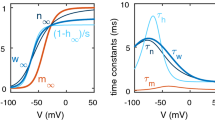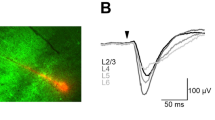Summary
This study documents the ability of individual neurons of theHomarus americanus cardiac ganglion to produce driver potentials (regenerative, 20 mV, 200 ms depolarizing responses to depolarization).
Partial block of impulse traffic, achieved by ligaturing, indicates that chemically mediated synaptic transmission is not essential to burst formation, initiation or coordination, but increases burst duration (Figs. 1, 9); electrotonic coupling suffices.
Ligatures placed within 1.2 mm of the soma of Cells 1 or 2 separate impulse supporting axon from a soma-proximal neurite region which does not support impulses, but generates a driver potential in response to depolarizing current (Figs. 2, 6, 10). Driver potentials persist with ligatures as close as 200 μm. Such a ligature excludes neuronal interaction via axon collaterals observable with lucifer yellow (Fig. 7), thus establishing that driver potentials are endogenous. Driver potentials are unaffected by TTX (Fig. 2, Table 1).
Driver potentials ofHomarus neurons isolated by ligaturing were compared with those ofPortunus isolated by TTX. The measured parameters are very similar (Table 1), as are effects of altered membrane holding potential (Figs. 3, 4) and drugs (Fig. 5). Driver potentials are reversibly blocked by Mn (4 mmol/l) or Cd (0.5 mmol/l). Tetraethylammonium chloride (5–50 mmol/l) reversibly augments the amplitude and duration of driver potentials; hyperpolarizing afterpotentials remain.
Driver potential responses during repetitive stimulation indicate a relatively refractory period and capability for graded responsiveness (Fig. 8).
Anterior neurons (Cells 1 or 2) isolated by ligaturing rarely exhibited spontaneity (Figs. 10, 11). Cell 3, isolated by 3 ligatures, consistently showed rhythmic burst generation (Fig. 11) arising from pacemaker depolarization.
The capability of driver potential generation in response to non-specific depolarization endows individual neurons with their pattern-forming ability.
Similar content being viewed by others
Abbreviations
- TEA :
-
tetraethylammonium
- TTX :
-
tetrodotoxin
References
Alexandrowicz JS (1932) The innervation of the heart of the Crustacea. I. Decapods. Q J Microsc Sci 75:181–249
Alving BO (1968) Spontaneous activity in isolated somata ofAplysia pacemaker neurons. J Gen Physiol 45:29–45
Arvanitaki A, Chalazonitis N (1961) Slow waves and associated spiking in nerve cells ofAplysia. Bull Inst Oceanogr 1224:1–15
Benson JA (1980) Burst reset and frequency control of the neuronal oscillators in the cardiac ganglion of the crab,Portunus sanguinolentus. J Exp Biol 87:285–313
Berlind A (1982) Spontaneous and repetitive driver potentials in crab cardiac ganglion neurons. J Comp Physiol 149:263–276
Bullock TH (1965) Mechanisms of integration. In: Bullock TH, Horridge GA (eds) Structure and function in the nervous systems of invertebrates. Freeman, San Francisco, pp 253–351
Bullock TH, Terzuolo CA (1957) Diverse forms of activity in the somata of spontaneous and integrating ganglion cells. J Physiol (Lond) 138:341–364
Cole WH (1941) A perfusing solution for the lobster (Homarus) heart and the effects of its constituent ions on the heart. J Gen Physiol 25:1–6
Connor JA (1969) Burst activity and cellular interaction in the pacemaker ganglion of the lobster heart. J Exp Biol 50:275–295
Cooke IM, Hartline DK (1975) Neurohormonal alteration of integrative properties of the cardiac ganglion of the lobsterHomarus americanus. J Exp Biol 63:33–52
Cooke IM, Sullivan RE (1982) Hormones and neurosecretion. In: Atwood HL, Sandeman DC (eds) The biology of Crustacea, vol 3. Academic Press, New York, pp 206–290
Cooke IM, Tazaki K (1979) Driver potentials isolated in crustacean cardiac ganglion cells by ligaturing. Soc Neurosci Abstr 5:498
Friesen WO (1975) Physiological anatomy and burst pattern in the cardiac ganglion of the spiny lobsterPanulirus interruptus. J Comp Physiol 101:173–189
Hagiwara S (1961) Nervous activities of the heart in Crustacea. Ergeb Biol 24:287–311
Hagiwara S, Bullock TH (1957) Intracellular potentials in pacemaker and integrative neurons of the lobster cardiac ganglion. J Cell Comp Physiol 50:25–47
Hagiwara S, Watanabe A, Saito N (1959) Potential changes in syncytial neurons of the lobster cardiac ganglion. J Neurophysiol 22:554–572
Hartline DK (1967a) Impulse identification and axon mapping of the nine neurons in the cardiac ganglion of the lobster,Homarus americanus. J Exp Biol 47:327–340
Hartline DK (1967b) Integrative physiology of the lobster cardiac ganglion. PhD Thesis, Harvard University
Hartline DK (1979) Integrative neurophysiology of the lobster cardiac ganglion. Am Zool 19:53–65
K. Tazaki and I. Cooke: Driver Potentials of Lobster Neurons
Hartline DK, Cooke IM (1969) Postsynaptic membrane response predicted from presynaptic input pattern in the lobster cardiac ganglion. Science 146:1080–1082
Lang F (1971) Intracellular studies on pacemaker and follower neurones in the cardiac ganglion ofLimulus. J Exp Biol 54:815–826
Matsui K, Kuwasawa K, Kuramoto T (1977) Periodic bursts in large cell preparation of the lobster cardiac ganglion (Panulirus japonicus). Comp Biochem Physiol 56A:313–324
Mayeri E (1973) Functional organization of the cardiac ganglion of the lobster,Homarus americanus. J Gen Physiol 62:448–472
Maynard DM (1955) Activity in a crustacean ganglion. II. Pattern and interaction in burst formation. Biol Bull 109:429–436
Maynard DM (1960) Circulation and heart function. In: Waterman TH (ed) The physiology of Crustacea. Academic Press, New York
Maynard DM (1961) Cardiac inhibition in decapod Crustacea. In: Florey E (ed) Nervous inhibition. Pergamon, New York, pp 149–178
Miller MW, Sullivan RE (1981) Some effects of proctolin on the cardiac ganglion of the Maine lobster,Homarus americanus (Milne Edwards). J Neurobiol 12:629–639
Shimahara T (1969a) The inhibitory postsynaptic potential in the cardiac ganglion cell of the lobster,Panulirus japonicus. Sci Rep Tokyo Kyoiku Daigaku Sect B 14:9–26
Shimahara T (1969b) The effect of the acceleratory nerve on the electrical activity of the lobster cardiac ganglion. Zool Magazine 78:351–355
Stewart W (1978) Functional connections between cells as revealed by dye-coupling with a highly fluorescent naphthalamide tracer. Cell 14:741–759
Strumwasser F (1967) Types of information stored in single neurons. In: Wiersma AG (ed) Invertebrate nervous systems. Univ of Chicago Press, Chicago, pp 291–319
Tazaki K (1971a) The effects of tetrodotoxin on the slow potential and spikes in the cardiac ganglion of a crab,Eriocheir japonicus. Jpn J Physiol 21:529–536
Tazaki K (1971b) Small synaptic potentials in burst activity of large neurons in the lobster cardiac ganglion. Jpn J Physiol 21:645–658
Tazaki K, Cooke I (1979a) Spontaneous electrical activity and interaction of large and small cells in the cardiac ganglion of the crab,Portunus sanguinolentus. J Neurophysiol 42:975–999
Tazaki K, Cooke I (1979b) Isolation and characterization of slow, depolarizing responses of cardiac ganglion neurons in the crab,Portunus sanguinolentus. J Neurophysiol 42:1000–1021
Tazaki K, Cooke I (1979c) The ionic bases of slow, depolarizing responses of cardiac ganglion neurons in the crab,Portunus sanguinolentus. J Neurophysiol 42:1022–1047
Tazaki K, Cooke IM (1983) Topographical localization of function in the cardiac ganglion of the crab,Portunus sanguinolentus. J Comp Physiol 151:311–328
Watanabe A, Bullock TH (1960) Modulation of activity of one neuron by subthreshold slow potentials in another in lobster cardiac ganglion. J Gen Physiol 43:1031–1045
Watanabe A (1958) The interaction of electrical activity among neurons of lobster cardiac ganglion. Jpn J Physiol 8:305–318
Watanabe A, Obara S, Akiyama T (1967) Pacemaker potentials for the periodic burst discharge in the heart ganglion of a stomatopod,Squilla oratoria. J Gen Physiol 60:839–862
Wilson WA, Wachtel H (1974) Negative resistance characteristics essential for the maintenance of slow oscillations in bursting neurons. Science 186:932–934
Author information
Authors and Affiliations
Rights and permissions
About this article
Cite this article
Tazaki, K., Cooke, I.M. Separation of neuronal sites of driver potential and impulse generation by ligaturing in the cardiac ganglion of the lobster,Homarus americanus . J. Comp. Physiol. 151, 329–346 (1983). https://doi.org/10.1007/BF00623908
Accepted:
Issue Date:
DOI: https://doi.org/10.1007/BF00623908




